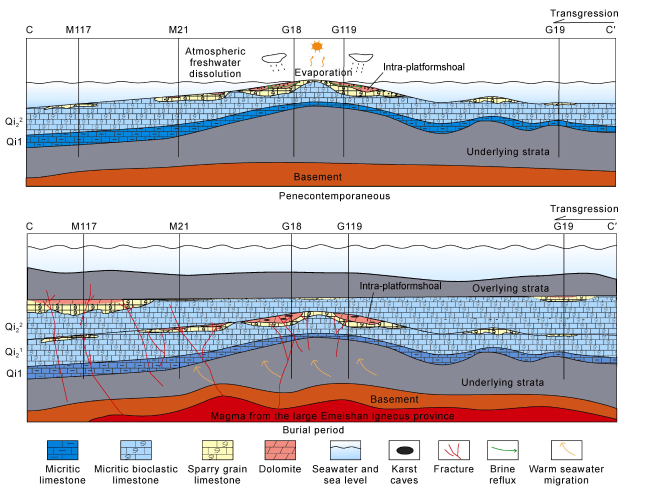Introduction
1. Regional geology and sedimentary
Fig. 1 Well location in Gaoshiti-Moxi area (a) and stratigraphic column diagram of Permian Qixia Formation (b). |
Fig. 2 Typical petrological characteristics of the Qixia Formation in the Gaoshiti-Moxi area. (a) Sparry bioclastic limestone with fossils of red algae, fusulinid, foraminifer and other organisms; 4 479.80 m; Well M151; plane-polarized light; (b) Medium-fine dolomite; 4 530.80 m; Well M151; plane-polarized light; (c) Micritic-sparry bioclastic limestone; 4 525.41 m; Well M151; plane-polarized light; (d) Micritic bioclastic limestone with fractures filled with two stages of calcite; 4 529.45 m; Well M151; plane-polarized light. |
Fig. 3 Sedimentary microfacies of the Qixia Formation in Gaoshiti-Moxi area (the section location shown in |
2. Reservoirs of Qixia Formation in Gaoshiti-Moxi area
2.1. Reservoir petrological characteristics
Fig. 4 Typical lithologic slices and cathodoluminescence characteristics of the Qixia Formation in Gaoshiti-Moxi area. (a) Sparry bioclastic limestone; 4 570.70 m; Well M117; plane-polarized light; (b) It is the same horizon as Fig. a: dark light in cathodoluminescence test; (c) Anhedral fine-medium dolomite with visible residual bioclastic structure; 4 690.46 m; Well M42; plane-polarized light; (d) It is the same horizon as Fig. c: dark light in cathodoluminescence test; (e) Anhedral fine-medium dolomite (bottom) and medium-coarse dolomite (top); 4 577.15 m; Well M117; plane-polarized light; (f) It is the same horizon as Fig. e: dark light (bottom), and turbid core and bright rim structure (top); cathodoluminescence; (g) Medium-coarse dolomite; 4 575.16 m; Well M117; plane-polarized light; (h) It is the same horizon as Fig. g: turbid core and bright rim structure; cathodoluminescence; (i) Medium-coarse dolomite; 4 523.23 m; Well M151; plane-polarized light; (j) It is the same horizon as Fig. i: turbid core and bright rim structure; cathodoluminescence; (k) Saddle dolomite with bending crystal surface; 4 373.14 m; Well M117; plane-polarized light; (l) It is the same horizon as Fig. i; bright red rim; cathodoluminescence. |
2.2. Reservoir pore type
Fig. 5 Pores in the dolomite reservoir of the Qixia Formation in Gaoshiti-Moxi area. (a) Crystalline dolomite with intercrystalline pores; 4 531.35 m; Well M151; plane-polarized light; (b) Crystalline dolomite with bay-like intercrystalline dissolution pores; 4 500.63 m; Well M150; plane-polarized light; (c) Crystalline dolomite with intercrystalline dissolution pores filled with a small amount of asphalt; 4 500.18 m; Well M150; plane-polarized light; (d) Crystalline dolomite with intercrystalline dissolution pores filled with a small amount of asphalt; 4 523.12 m; Well M151; plane-polarized light; (e) Grey crystalline dolomite with centimeter-level karst caves semi-filled with early calcite and late euhedral dolomite; 4 531.26 m; Well M151; (f) Grey crystalline dolomite with fracture-type karst caves; 4 523.12 m; Well M151; (g) Crystalline dolomite with structural fractures and dissolved fracture; 4 687.18 m; Well M42; plane-polarized light; (h) Crystalline dolomite; dissolution along the fracture; 4 501.01 m; Well M150; plane-polarized light; (i) Crystalline dolomite with micro-fractures communicating intergranular pores; 4 502.33 m; Well M150; plane-polarized light. |
2.3. Reservoir physical properties and types
3. Controlling factors and reservoir formation model of high-quality dolomite reservoirs
3.1. Controlling factors
3.1.1. Micro-paleogeomorphology controls the distribution of intra-platform shoals.
Fig. 6 Stratigraphic thickness of Liangshan Formation and Qixia Formation in Gaoshiti-Moxi area. |
Fig. 7 Development and evolution models of intra-platform shoals of the Qixia Formation in Gaoshiti-Moxi area (The section location is shown in |
3.1.2. Shoals control the distribution of dolomite
Fig. 8 Thickness contour map of dolomite of the Qixia Formation in Gaoshiti-Moxi area. |
3.1.3. Two-stages dolomitization controls the development of high-quality dolomite reservoirs.
Fig. 9 δ18O and δ13C values distribution of different types of carbonates in the Qixia Formation in Gaoshiti-Moxi area. |
Fig. 10 87Sr/86Sr of different types of carbonates in the Qixia Formation in Gaoshiti-Moxi area [20]. |
Fig. 11 Distribution pattern of rare earth elements in dolomite and limestone of the Qixia Formation in Gaoshiti-Moxi area. |
Fig. 12 Statistical histogram of homogeneous temperature of the inclusions in medium-coarse dolomite and saddle dolomite of the Qixia Formation in Gaoshiti-Moxi area. |
Fig. 13 Hydrothermal dolomitization, dissolution and transformation to the Qixia Formation in Gaoshiti-Moxi area. (a) Crystalline dolomite with abundant pores (the upper right is fine-medium dolomite, and the left is medium-coarse dolomite modified by hydrothermal fluids); 4 501.01 m; Well M150; plane-polarized light; (b) Crystalline dolomite with abundant pores (the lower right is medium-coarse dolomite modified by hydrothermal fluids); 4 500.54 m; Well M150; plane-polarized light; (c) Crystalline dolomite with abundant pores (the upper is tight fine dolomite, and the lower right is medium-coarse dolomite modified by hydrothermal fluids; 4 506.88 m; Well M151; plane-polarized light. |
3.2. Reservoir formation models
Fig. 14 The development and evolution model of high-quality dolomite reservoirs of the Qixia Formation in Gaoshiti-Moxi area (The section location is shown in |















